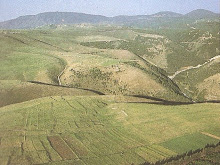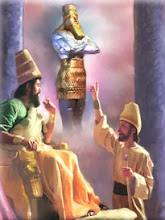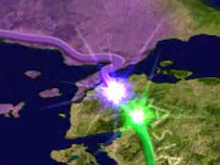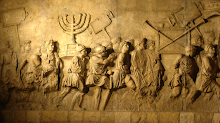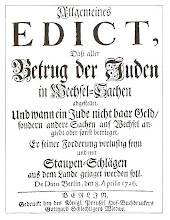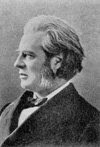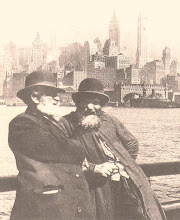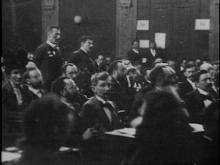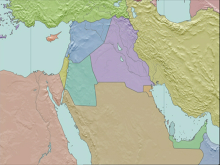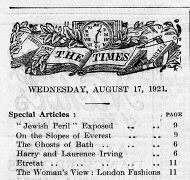A FOURTH SIGNPOST CHALLENGE:
THE 'PROPHETIC DAY-YEAR PRINCIPLE'
We have already seen in previous archive notes that three well-known and current religious organizations employ some level of Signpost reasoning that might challenge the Clarke – Guinness understanding:
Jehovah’s witnesses
the Bahai
Seventh Day Adventists
All these use the prophetic ‘Day for a Year’ formula and all apply the prophetic content of the book of Daniel to themselves or some aspect of their belief system. None of these views, however, invalidate the Signpost assertion that it is the Jewish nation and its 2500 year history, subservient to gentile domination and in Diaspora, that is the universal theme of Daniel, with the eventual regaining of national Sovereignty and the Covenant Land.
The first advent of Messiah is also foreseen in Daniel chapter 9 centuries in advance of it's actual occurrence, and the consequences to Israel of His rejection are also prophesied, as we shall note.
But there is one other challenge to the Signpost Year view and one that attacks the position taken by the other three groups here mentioned. It simply states that the prophetic Day-Year Principle is a contrivance and cannot really be substantiated from scripture. It is a view especially important to atheists and others who do not (or cannot) condone the idea of divinely ordained prophecy. After all was it not the ancients who rightly said, ‘Show us the future and then we will know you are a god’?
There are thee principal texts in scripture that are frequently used to substantiate the Day -Year Principle, but there are numbers of other reasons for maintaining the validity of the idea.
In the first incident around the period 1400 BC, the nation of Israel had sent out a number of spies to reconnoiter the land of Canaan with a view to conquest. They spent 40 days assessing the land and peoples. The pagan nations there engaged in evil practices such as idolatrous child sacrifice to images. However, Israel was faithless and disobedient in not exacting judgment on those idolaters and the penalty for this fecklessness was to wander in the wilderness for 40 years, ‘a year for each day’ the land had been spied on. The text at Numbers 14:34 illustrates this:
‘According to the number of days in which you spied out the land, forty days, a year for each day, you shall bear your iniquity for forty years, and you shall know my displeasure.’
A reiteration of the Day - Year Principle is further proposed at Ezekiel 4:6. The prophet around the year 920 BC was to enact a representation of the continuing faithlessness of the nation of Israel and Judah, which had persisted in the latter case for 40 previous years. Modeling this, Ezekiel had to lie on one side continuously for 40 days as a symbol of Judah’s punishment. The text reads,
‘And when you have completed these (390 days of punishment for Israel), you shall lie down a second time, but on your right side, and bear the punishment of the house of Judah. Forty days I assign you, a day for a year.’
We see then in two totally different instances, and occurring some 500 years apart, the parallel that numbers of days and years are weighted and assigned equivalence in retribution for disobedience. This biblical observation was extended by scholars such as Clarke and Guinness to apply to all the prophetic utterances of the book of Daniel from which the Signpost Year predictions, 1902, 1917, 1947-8 and 1967 were thereby projected.
A third and certainly most interesting example of the acclaimed Day - Year Principle is that regarding the Anointing (by baptism) and death (by crucifixion) of Jesus the Messiah in the year 29 and 31 AD respectively. Daniel prophesied around 500 BC that,
‘Seventy weeks are determined for your people and for your holy city.
To finish the transgression,
To make an end of sins,
To make reconciliation for iniquity,
To bring in everlasting righteousness,
To seal up vision and prophecy,
And to anoint the Most Holy.
Know therefore and understand,
That from the going forth of the command
To restore and build Jerusalem
Until Messiah the Prince,
There shall be seven weeks and sixty-two weeks.
The street shall be built again, and the wall,
Even in troublesome times.
And after the sixty-two weeks Messiah shall be cut off, but not for Himself;
And the people of the prince who is to come
Shall destroy the city and the sanctuary.
And the end shall be with a flood.
And till the end of the war desolations are determined.’ (NKJV)
A detailed study of this prophecy would take volumes in itself but if we take a ‘week’ as consisting of seven days, then the city of Jerusalem would take (7x7=) 49 prophetic years to rebuild from the point it’s reconstruction was commissioned (in 457 BC by Artaxerxes). Messiah would be Anointed at the end of a further (62x7=) 434 prophetic years, which locates the year 27 AD and Jesus’ baptism, allowing for no year zero in the BC- AD transition. That Messiah would be cut off (an idiom for His death) in the middle of the final ‘seven’ prophetic years pinpoints a further three and a half years later, or 31 AD as the year of His crucifixion.
For this prophecy to have found fulfillment in Jesus Christ with the following destruction of Jerusalem and its Temple sacrifices not long after also, and to which Christ Himself certainly alluded back then in His time as imminent in fulfillment (Matthew 23:15), then these prophetic occurrences demand one essential consession; that here in Daniel nine, prophetic Days are equal to prophetic Years.
And, in one of several senses, this dose exactly what the prophecy at verse 24 said it would accomplish in terms of Messiah; He would ‘seal up prophecy and vision.’ In other words, He would demonstrate the Day-Year key and verification to understanding the rest of divine prophetic scripture.
Dissenters from the Day -Year Principle, and the very idea of divinely inspired prophecy especially, point out specific objections to each of the three texts discussed.
Firstly, they would say, the question of the spies in the book of Numbers has nothing to do with establishing ‘a principle’ especially in prophecy at least. The 40 years assignment is simply a judgment and one that would be enacted immediately, rather than at some later prophetic epoch centuries away. To build an exegetical prophetic structure or equivalence around this instance is very poor scholarship indeed.
The Ezekiel example is just as tenuous. There is nothing futuristic or prophetic at all in this example. In actual fact, Ezekiel is to model a situation that has already taken place. How can this retrospective act be ‘prophetic’ in any way?
Finally, Daniel chapter nine in the original language talks only of ‘sevens’, but seven what? To make out these are ‘days’ yet alone ‘prophetic year–days’ is, again, stretching scripture and interpretation beyond credibility. And anyway, many attempts have been made to hammer this text into shape and fit it into some sort of Messianic fulfillment. Given all the ambiguity in the verses of Daniel nine, there is little wonder that eventually several (though contradictory) solutions that approximate to the time of Jesus of Nazareth can be contrived.
Having established the four principal views that apparently challenge the Signpost Year explanation, the Witnesses, Adventist, Bahai, and the Day - Year dissenters, we are now in a position to tackle all of these views and demonstrate the tentative nature of their apologetic in comparison to that of the Signpost Year proposal.
9aug20
SIGNPOST YEAR 1948 THE BIRTH OF ISRAEL – THE “BIG BANG” OF TODAY’S GLOBAL CONTENTIONS BETWEEN THE WEST AND ISLAM.
As noted on a number of occasions, writers, broadcasters and historians often unwittingly point to those years and events that constitute The Signpost Years as highly significant, landmark or major turning points. A recent further example comes, this time, from an international movie-maker.
Interviewed on the BBC radio program ‘The Strand’, Palestinian producer Elia Suleiman, living and filming in Israel, discussed his current production ‘The Time That Remains’ to be released across Europe from August 2009.
Elia was asked, for example, how he had been able to acquire a Tank in his earlier movie ‘The Divine Intervention’ (2002) that surreally depicts life in Israel and he noted it had not been feasible; the Israeli army had told him he could borrow one, but he had to maintain it in pristine condition, where his intention was to blow one up for the sake of the movie. The French army had finally provided one for his film instead!
Then, at the end of the interview, the question was put to him:
“You’ve said about ‘The Time That Remains’ that, ‘this isn’t a film merely about Palestine. Palestine has been globalized, and it has exported its tensions’ - I’m quoting you. And I wonder if you can just describe what you mean by that?”
He replied,
“I think that 1948 could be regarded as the ‘Big Bang’ of global tension. And the implanting of Israel which had a lot of strategic reasons, from much of the colonial world actually, soon after caused and had the consequences of all what we see today, from Islamists everywhere, and Mujahideem everywhere, who actually also turned Palestine into their own cause, and similarly on the other side of the spectrum.
And I think that Palestine has become simply the microcosm of what is happening in the world today, and the fact that nobody actually comes to touch on 1948 as this sort of ‘Big Bang’ is simply, by de factor, making the situation and conflict in the Middle East continue. It seems like it became a metaphor for all this other so called ‘anti-occidental’ resistance.”
(Interview ends there with thanks for his participation).
Yet again, secularists, journalists, Zionists, Moslems, atheists and all, are readily capable of singling out The Signpost Years.
- BBC World Service ‘The Strand’ (Items and themes in current world News as reflected in the Arts and Culture) broadcast several times during 9aug10-11.
SIIGHNPOST 1917 IDENTIFIED IN NEW DVD RELEASE
A new and powerful two-hour DVD cataloguing "the attempts at peace and the major milestones in Israeli history" went on offer from the 24th August 2009, advertised via the monthly journal 'Israel Today' and its free daily email news update.
Spanning the modern history of the Jewish State and the events leading to its inception, the DVD is titled 'Israel's War History.' The documentary comes up to present times, including the recent conflict in Lebanon in the summer of 2006, and its aftermath.
From the Signpost perspective it is hardly surprising that the DVD deals particularly with two key Signpost Years, 1947-8 and 1967. However, the feature-length program traces the original issues, and the starting point of all this modern history of Middle East conflict, still ongoing, to another of the critical key Signpost Years, and which it also singles out specifically. According to Israel Today,
“ ‘Israel’s War History’ is the most up-to-date comprehensive account of the battles that have shaped Israel’s history and society. Tracing the Arab-Israeli conflict to British occupation of Palestine in 1917, ‘Israel’s War History’ portrays the entire history of the State of Israel.”
The ‘fall of Jerusalem’ to Field Marshal Edmund Allenby commanding the British army, and the renown British Balfour Declaration, both in 1917, were indeed the major ‘starting point of the modern Arab-Israeli conflict.’ The DVD’s key turning landmarks for the Jews and Arabs are represented indelibly so in the annals of secular history. But remarkably, decades before 1917 they were also there in the prophetic writings of Guinness and Clarke, as what we call today - ‘The Signpost Years.’
9aug25
